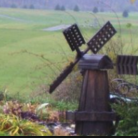
Yesterday, October 26, 2024, would have been my and Ed’s 50th wedding anniversary. We had so hoped and dreamed of reaching that milestone, but God had other plans for our lives. Many of our friends and relatives have already or are reaching that celebration point, and I’m very happy for them! They made it!
A lifetime of love is not a mere trifle. Yet it seems that the years evaporated far too quickly. Our 49 years together, married 48 years and 3 months, did not happen without the ups and downs being mixed and stirred up well. It involves loving your spouse enough to be there in the best of times and the worst of times… to keep moving forward when life hands you those bitter lemons, to carry your loved one during serious illness or disability, to remain at the side of the one who falls rather than taking the easy way out, helping them stand again on solid ground, to encourage and praise each other in new endeavors, and to simply share the depth of precious memories made as a couple and a family… for time relentlessly moves forward… a unique relationship, one that could never be duplicated…
After dating for several months, Edward wrote me a song in a letter, a habit of his. Thinking it was his own compilation, he admitted it was the Beach Boys’ song, “Wouldn’t it be nice?” Proposing to me, of course I said yes! He could only afford a tiny little diamond, but I loved that gem with the ring resembling a petal or leaf. I didn’t need anything large and ostentatious to show our commitment. Years later, I took my old ring that needed repairs, and my mother’s broken white gold ring which my father had replaced, and was able to purchase a new setting, adding two more tiny diamonds from a ring my mother had, one on each side of my own. To me it represented each of us separately, the center diamond signifying our marriage union… with a love that never fades.
When we first began dating, he’d also told me that if I ever felt sorry for him, then I didn’t belong at his side. So, I tended to take him for granted at times, and assumed he could do almost anything despite his limited vision, which he often could because he was determined to do his best at what everyone else could do so easily with sight.
We didn’t have much then except love. But what we had we shared. Our first home was a 12x64 ft trailer, part of his wages. He worked on the farm with his father until June 1985 when he had a major retinal detachment requiring 9-hour surgical repair, told by the eye surgeon he could no longer be a dairy farmer. With three young ones at the time, it was devastating news, and I returned to work to support us. In time, Ed went to the Carroll Center for the Blind in Newton, MA, and worked locally for two companies, often wishing he’d known as a teen to take advantage of free college for a business degree. But God was with us in the many difficulties encountered, working out each situation with a purpose in our lives.
Yes, we had our ups and downs. We faced many challenges, difficulties and tragedies, including the death of our oldest daughter at age 25. We were exhausted physically and emotionally, upset at each other at times, but we worked through the issues. We were not perfect. We were human. We had faults too. Loving and forgiving each other, we stayed together… for better or for worse, in sickness and in health, as the typical wedding vows say… while our gracious God walked beside us, every step of the way, always guiding, leading, and blessing us on this road called life.
Anniversaries…
Linda A. Roorda
Anniversaries…
Like the years they recall
Are simply milestones
And bookends
Rich with memories
Tucked into the pockets
Of endless time
As bits and pieces
Like childhood toys
Are gathered at whim
To be recalled
For their special treasures
Hidden deep within
That readily affirm
With broader meaning
In sight and sound
From shared joys and tears
Through difficult storms
To peaceful harbors
As the hand of comfort
Envelops my soul
In embrace secure
Like a blanket warm
That leaves me knowing
The love I feel
And share with you
Has come full circle
In the gift of self
Our memories treasured.
~~
- Read more...
- 0 comments
- 141 views

